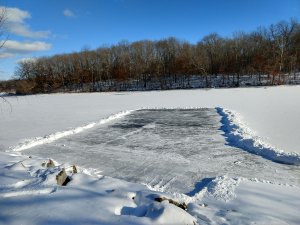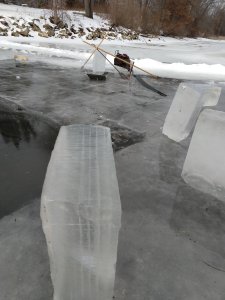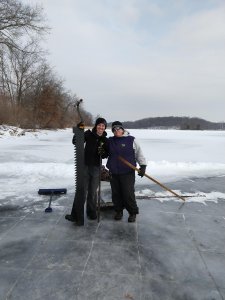The intersection of History and Climate: Ice Harvesting in Southeast Michigan
December 7, 2022 By Pat Bigelow, Supervising Interpreter- Farm
Late January 2019, myself and another Kensington Metropark Farm Center staff member walked out onto the frozen surface of Kent Lake. It was a beautiful day with the sun gleaming off a dusting of snow that covered the ice. About twenty feet from shore we shoveled clear a patch of ice. I raised my ice spud and brought it down. It went clear through and water welled up onto the ice. I involuntarily gulped, the ice was only a couple inches thick and I did not want an icy bath. We gingerly walked back to shore to discuss our plans. We had come out to check the ice conditions in preparation for a historic ice harvesting demonstration program that was coming up in a little over a week. We debated cancelling the event but decided to give it a couple more days as the forecast called for a polar vortex to set in soon.
The next day, the temperatures had dropped into the twenties and the ice was closing in on three inches thick so we carefully shoveled snow off a wide patch of ice where we hoped to run the program. Snow is a natural insulator and by removing it we were helping the cold set in and the ice freeze thicker. Over the next week, the daily high temperatures dropped to the single digits and the wind chill dropped into the negatives. On a farm, temperatures like that mean a constant battle to keep water tanks from freezing and animals warm. After chores were done, every day the farm staff shoveled the ice free of drifting snow.

Midweek we knew that the program could go ahead, and we began to set up the equipment. Long wooden troughs were lined up on the ice to allow the cut blocks of ice to be slid to shore. A lever action ice hoist was set up to lift the blocks into the back of a waiting wagon. Friday, February 1st, we offered a Homeschool: Ice Harvest program. The polar vortex was weakening, and the temperatures were back in the twenties. From a small starter hole, the ice saw bit deep and we cut quickly around the block, arms moving in a circular pattern as the saw only cuts on the downstroke. The first block is always the hardest to remove so once it was cut free we used spiked pike poles to push the block down and flip it on edge. Then the block was grasped with ice tongs and the block heaved onto the ice. It was a beauty! Two feet square and 13 inches thick. The top 3 inches were cloudy and white, but the rest was crystal clear with visible bubble layers marking each day of the polar vortex. The thickest layer showed that ice had thickened by an inch and a half in a single night.

Saturday, February 2nd the sun was shining, and the temperatures were in the upper 30s. About 150 people came out to see the blocks cut from the lake and the try their hand with some of the historic ice harvesting tools. By Sunday though the temperatures had climbed to nearly 50 degrees and the warm sun was causing our wooded troughs to melt into the ice and we had to quickly remove our equipment. By the end of the day nearly an inch of slush was pooled on top of Kent Lake’s ice. Since that 2019, Kensington Metropark Farm Center has been unable to host a historic ice harvesting event due to a string of mild winters. A similar issue has been reported at Living History farms and historic centers throughout the Midwest and New England.

Ice harvesting was the first “crop” of the new year for many Michigan farmers and, in many farming communities, residents would band together to cut ice from a nearby lake and store it in a communal ice house to draw shares from in the warm months to keep food from spoiling. From the 1880s to the 1920s, ice became big business as railroads expanded and brought ice from rural areas to the growing cities in the Midwest and East Coast. At one time, it was the ninth largest industry in the United States and ice was shipped not only around the country but even internationally as far as India. Teams of ice cutters and draft horses used specialized tools and worked long shifts cutting ice from many local lakes and rivers to meet this demand. Until the invention of refrigeration, the health of people in cities across the United States depended upon the harvest, shipping, storage, and delivery of ice. The last leg of that journey from lake to home was performed by the “ice man”, whose horse-drawn wagon transported the ice from an urban insulated warehouse to the homes and apartments of their customers. The average home had an insulated ice box which used 50lb ice blocks to chill food.
Thanks to refrigeration, this labor-intensive method of food preservation is no longer needed, but it is worth considering that this activity, once so critical to our nation’s growth, can no longer be performed due to our changing climate. The ice man’s day may have been numbered long ago, but today many Michigan agricultural industries are having to consider whether their farm, their crops, their orchards, or their animals can adapt to Michigan’s increasingly warmer and more unpredictable weather. If not, they may too go the way of the ice man.
